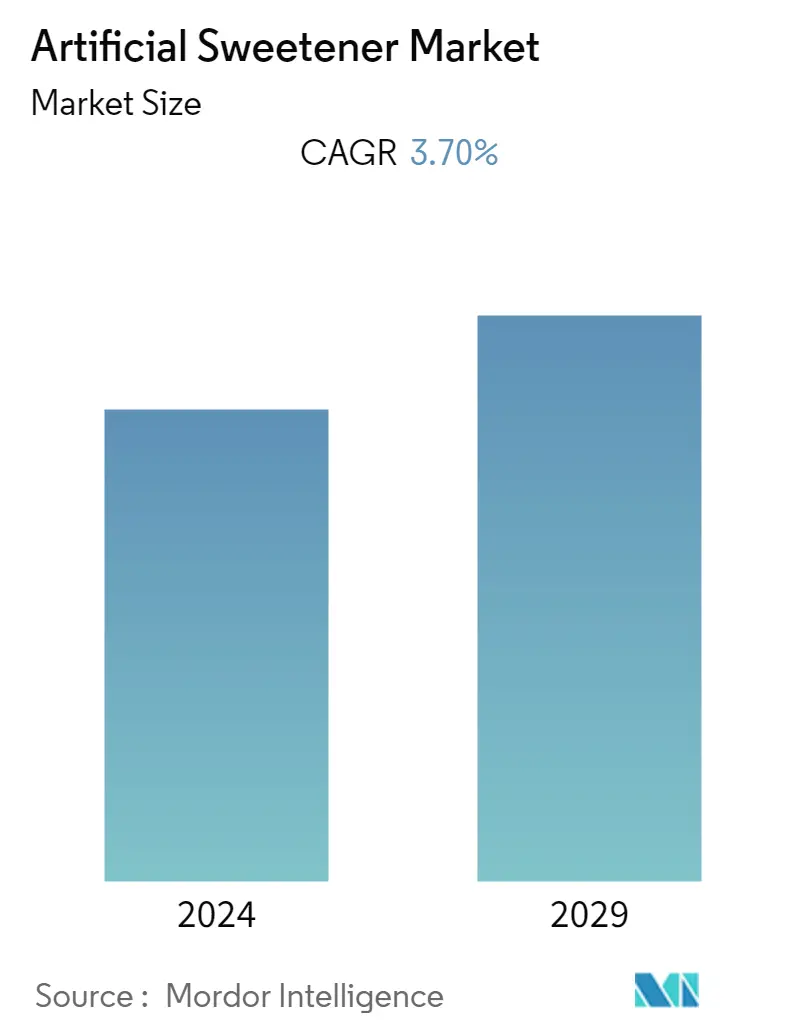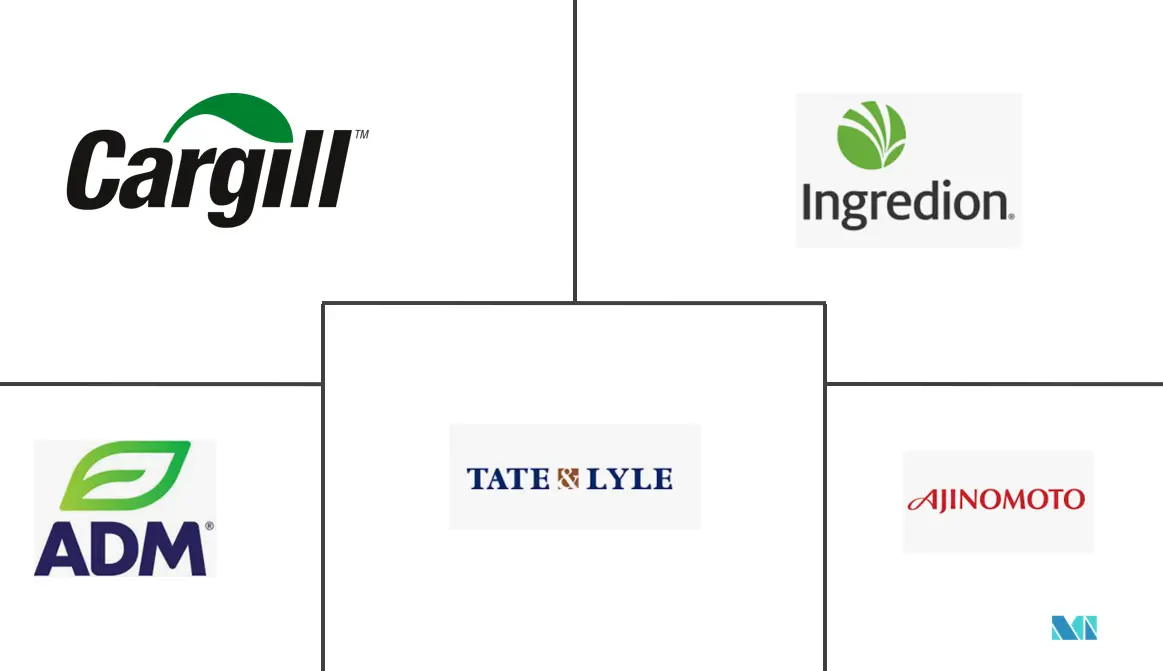Market Size of Artificial Sweetener Industry

| Study Period | 2019 - 2029 |
| Base Year For Estimation | 2023 |
| CAGR | 3.70 % |
| Fastest Growing Market | Middle East and Africa |
| Largest Market | Asia Pacific |
| Market Concentration | Low |
Major Players
*Disclaimer: Major Players sorted in no particular order |
Artificial Sweetener Market Analysis
The artificial sweetener market is projected to register a CAGR of 3.7% during the upcoming five years.
- Artificial sweeteners are commonly used as a substitute for sugar to maintain blood sugar levels, and they are commonly found in processed foods and beverages such as candies, jams, and baked goods. Aspartame, sodium benzoate, and saccharin are among the most popular artificial sweeteners available in the market, with aspartame being commonly used as a tabletop sweetener that is approximately 200 times sweeter than regular sugar. It is used in low-calorie desserts, sugar-free chewing gum, cereal, and coffee.
- The demand for no-calorie or low-calorie versions of food and beverages has been increasing at a rapid pace in recent years due to the rise in health-conscious consumers across the globe. Artificial sweeteners, which are sweeter than table sugar but have a lower energy density, have been widely used in the food and beverage industry in products such as soft drinks, sauces, chewing gum, jellies, dressings, baked goods, candy, fruit juice, ice cream, and more. The soft drink industry, in particular, has seen a significant increase in the consumption of artificial sweeteners due to the growing demand for low-sugar and diet beverages.
- While concerns about clean-label solutions and complex regulatory structures in Europe and the United States may limit market growth, product innovation and increasing demand for artificial sweeteners may help drive further growth in the market during the forecast period.
Artificial Sweetener Industry Segmentation
A sugar substitute is a food additive that provides a sweet taste like that of sugar while containing significantly less food energy than sugar-based sweeteners, making it a zero-calorie or low-calorie sweetener.
The artificial sweetener market is segmented by type (aspartame, acesulfame K, saccharin, sucralose, neotame, and other types), application (bakery, dairy, confectionery, beverages, soups, sauces and dressings, and other applications), and geography (North America, Europe, Asia-Pacific, South America, and Middle-East and Africa).
For each segment, the market sizing and forecasts have been done on the basis of value (in USD million).
| Type | |
| Aspartame | |
| Acesulfame K | |
| Saccharin | |
| Sucralose | |
| Neotame | |
| Other Types |
| Application | |
| Bakery Products | |
| Dairy Products | |
| Confectionery | |
| Beverages | |
| Other Applications |
| Geography | |||||||||
| |||||||||
| |||||||||
| |||||||||
| |||||||||
|
Artificial Sweetener Market Size Summary
The artificial sweetener market is experiencing a steady growth trajectory, driven by the increasing demand for low-calorie and sugar-free products. As consumers become more health-conscious, there is a growing preference for sugar alternatives that help maintain blood sugar levels without adding calories. This trend is particularly evident in the food and beverage industry, where artificial sweeteners are widely used in products such as soft drinks, baked goods, and dairy products. The market is characterized by the presence of popular sweeteners like aspartame, sodium benzoate, and saccharin, which are favored for their intense sweetness and low energy density. Despite challenges such as regulatory complexities and the demand for clean-label solutions, the market is poised for growth, supported by product innovation and the rising prevalence of obesity and diabetes.
The competitive landscape of the artificial sweetener market is marked by the presence of both large and small players, with companies like Tate & Lyle, Cargill, and Ajinomoto leading the charge. These manufacturers are leveraging advanced technologies to produce safe and effective sweeteners, while also adapting to changing consumer preferences for clean-label and non-GMO products. The market's expansion is further fueled by the increasing adoption of sugar alternatives among individuals seeking to reduce calorie intake and manage weight. As urban lifestyles contribute to unhealthy eating habits, the demand for convenient, low-calorie ready-to-drink beverages is expected to rise. Initiatives by major companies, such as PepsiCo's commitment to reducing sugar content in its products, highlight the industry's focus on catering to health-conscious consumers and driving market growth.
Artificial Sweetener Market Size - Table of Contents
-
1. MARKET DYNAMICS
-
1.1 Market Drivers
-
1.2 Market Restraints
-
1.3 Porter's Five Forces Analysis
-
1.3.1 Threat of New Entrants
-
1.3.2 Bargaining Power of Buyers/Consumers
-
1.3.3 Bargaining Power of Suppliers
-
1.3.4 Threat of Substitute Products
-
1.3.5 Intensity of Competitive Rivalry
-
-
-
2. MARKET SEGMENTATION
-
2.1 Type
-
2.1.1 Aspartame
-
2.1.2 Acesulfame K
-
2.1.3 Saccharin
-
2.1.4 Sucralose
-
2.1.5 Neotame
-
2.1.6 Other Types
-
-
2.2 Application
-
2.2.1 Bakery Products
-
2.2.2 Dairy Products
-
2.2.3 Confectionery
-
2.2.4 Beverages
-
2.2.5 Other Applications
-
-
2.3 Geography
-
2.3.1 North America
-
2.3.1.1 United States
-
2.3.1.2 Canada
-
2.3.1.3 Mexico
-
2.3.1.4 Rest of North America
-
-
2.3.2 Europe
-
2.3.2.1 Spain
-
2.3.2.2 United Kingdom
-
2.3.2.3 Germany
-
2.3.2.4 France
-
2.3.2.5 Italy
-
2.3.2.6 Russia
-
2.3.2.7 Rest of Europe
-
-
2.3.3 Asia-Pacific
-
2.3.3.1 China
-
2.3.3.2 Japan
-
2.3.3.3 India
-
2.3.3.4 Australia
-
2.3.3.5 Rest of Asia-Pacific
-
-
2.3.4 South America
-
2.3.4.1 Brazil
-
2.3.4.2 Argentina
-
2.3.4.3 Rest of South America
-
-
2.3.5 Middle-East and Africa
-
2.3.5.1 South Africa
-
2.3.5.2 United Arab Emirates
-
2.3.5.3 Rest of Middle-East and Africa
-
-
-
Artificial Sweetener Market Size FAQs
What is the current Artificial Sweetener Market size?
The Artificial Sweetener Market is projected to register a CAGR of 3.70% during the forecast period (2024-2029)
Who are the key players in Artificial Sweetener Market?
Tate & Lyle, Cargill, Ingredion, ADM and Ajinomoto are the major companies operating in the Artificial Sweetener Market.

